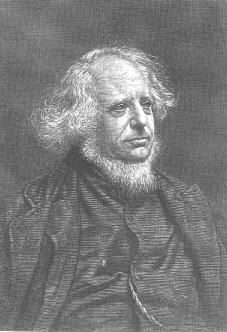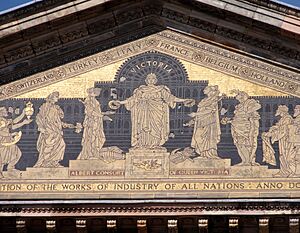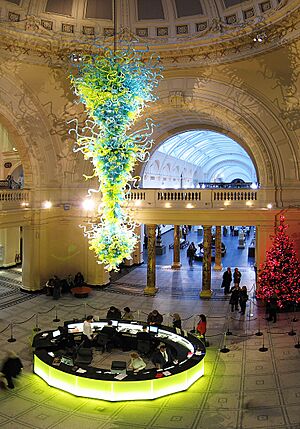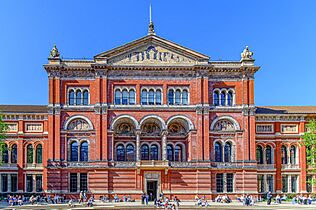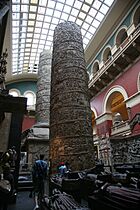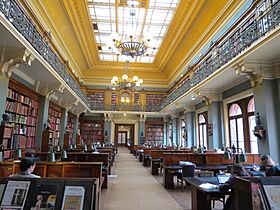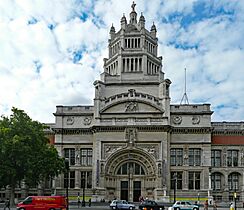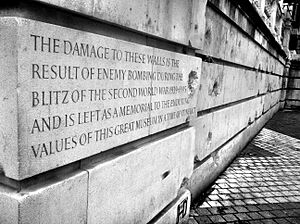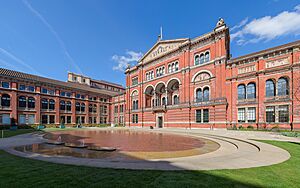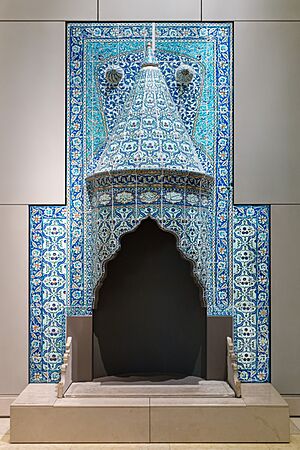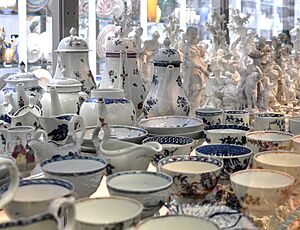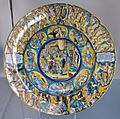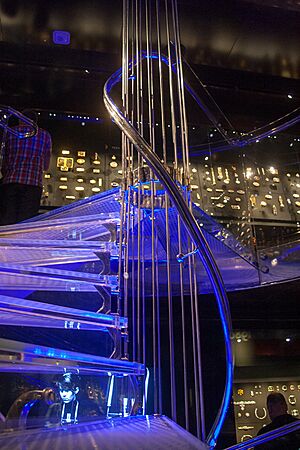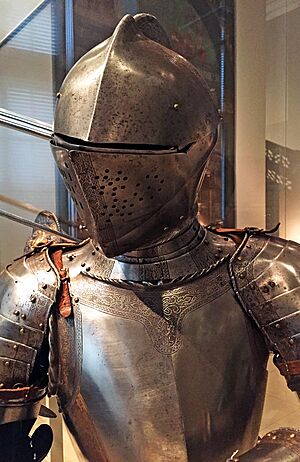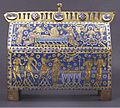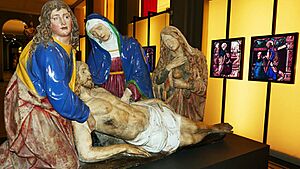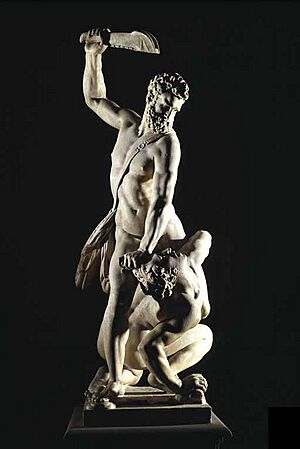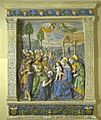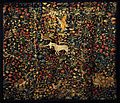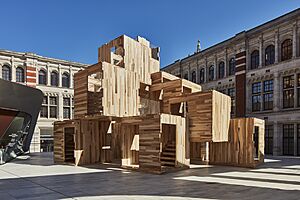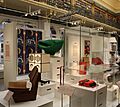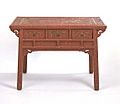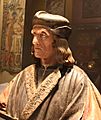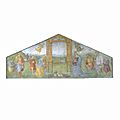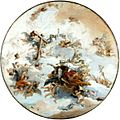Victoria and Albert Museum facts for kids

Logo introduced in 1989
|
|

The museum's main entrance
|
|
| Lua error in Module:Location_map at line 420: attempt to index field 'wikibase' (a nil value). | |
| Former name | Museum of Manufactures, South Kensington Museum |
|---|---|
| Established | 1852 |
| Location | Cromwell Road, Kensington and Chelsea, London, SW7 |
| Type | Art museum |
| Collection size | 2,800,000 objects in 145 galleries |
| Visitors | 3,110,000 (2023) |
| Owner | Non-departmental public body of the Department for Culture, Media and Sport |
| Public transit access | |
The Victoria and Albert Museum (or V&A) in London is a huge museum. It is the world's largest museum of applied arts, decorative arts, and design. It holds a permanent collection of over 2.8 million objects. The museum was started in 1852. It was named after Queen Victoria and Prince Albert.
The V&A is in Kensington and Chelsea, London. This area is sometimes called "Albertopolis". This is because of its links to Prince Albert. Other famous places nearby include the Natural History Museum and the Science Museum. The V&A is a public body. Like other national British museums, it is free to enter.
The museum covers about 12.5 acres. It has 145 galleries. Its collection shows 5,000 years of art. This ranges from ancient history to today. It includes cultures from Europe, North America, Asia, and North Africa. The V&A has some of the world's biggest collections. These include ceramics, glass, textiles, costumes, silver, jewellery, and furniture. It also has medieval objects, sculpture, drawings, and photographs.
The V&A has the world's largest collection of post-classical sculpture. Its Italian Renaissance sculpture collection is the biggest outside Italy. The Asian departments feature art from South Asia, China, Japan, Korea, and the Islamic world. The East Asian collections are among the best in Europe. The Islamic collection is one of the largest in the Western world. It is truly one of the largest museums globally.
Since 2001, the museum has been working on a big renovation. This "FuturePlan" cost £150 million. New European galleries for the 17th and 18th centuries opened in 2015. These galleries show European collections from 1600–1815. The Young V&A in east London is a branch of the museum. A new branch, V&A East, is being planned in London. The first V&A museum outside London, V&A Dundee, opened in 2018.
Contents
- Museum History
- Museum Architecture
- Museum Collections
- Architecture Collection
- Asian Art
- Books and Manuscripts
- British Galleries
- Cast Courts
- Ceramics and Glass
- Prints and Drawings
- Fashion Collection
- Furniture Collection
- Jewellery Collection
- Metalwork Collection
- Musical Instruments
- Paintings and Miniatures
- Photography Collection
- Sculpture Collection
- Textiles Collection
- Theatre and Performance
- Museum Activities
- Museum Partnerships
- Special Exhibitions
- Media Features
- Images for kids
- See also
Museum History
How the Museum Started
The Victoria and Albert Museum began with the Great Exhibition of 1851. Henry Cole was the museum's first director. He also helped plan the exhibition. At first, the V&A was called the Museum of Manufactures. It first opened to the public in May 1852. The collection was moved to Somerset House by September. At this time, it had both art and science items. Many exhibits from the Great Exhibition were bought for the V&A's first collection.
By 1854, talks began to move the museum to its current spot. It was renamed the South Kensington Museum. In 1857, the museum opened officially. Queen Victoria herself opened it on June 20th. The V&A was the first museum to offer food and drinks to visitors. It also started late-night openings. This was made possible by gas lighting. Henry Cole wanted to see what hours worked best for working people. The museum wanted to educate people and help industries.
In its early years, the museum focused on practical art. This was different from "High Art" at the National Gallery. It was also different from academic study at the British Museum. George Wallis strongly believed in art education for everyone. This led to the School of Design moving to the museum. It later became the Royal College of Art. By 1893, the "Science Museum" became a separate place.
Queen Victoria returned in 1899. She laid the foundation stone for a new building. During this event, the museum's name changed. It became the 'Victoria and Albert Museum'. Queen Victoria said she hoped it would be a "Monument of discerning Liberality and a Source of Refinement and Progress."
To celebrate 100 years since the renaming, the museum held an exhibition. It was called A Grand Design. It traveled across North America from 1997 to 1999. It then came back to London.
The 1900s to 1950s
The new Aston Webb building opened in 1909. King Edward VII and Queen Alexandra were there. In 1914, the Science Museum began construction. This marked the final separation of the art and science collections.
During the Second World War, most of the V&A's collection was moved. It went to safe places like a quarry in Wiltshire. Larger items stayed, protected by sandbags. From 1941 to 1944, some galleries became a school. It was for children evacuated from Gibraltar.
After the war, the Britain Can Make It exhibition was held. It attracted almost 1.5 million visitors in 1946. This show promoted British industrial design. Its success led to the Festival of Britain in 1951. Most collections returned to the museum by 1948.
From 1950 Onwards
In 1973, the V&A hosted a rock concert. This was part of its effort to reach young people. The band Gryphon played and talked about medieval music. This new idea helped bring young people to museums.
In 2001, the museum started a big renovation project. It was called "FuturePlan." This plan aimed to redesign all galleries and public areas. The goal was to display exhibits better and improve visitor access. A new area, the Exhibition Road Quarter, opened in 2017. It has a new entrance and an underground gallery. This was the museum's largest expansion in over 100 years.
In 2018, the Duchess of Cambridge became the museum's first royal patron. Also in 2018, V&A Dundee opened in Scotland. It focuses on Scottish design. The museum also runs the Young V&A in east London, which reopened in 2023.
Museum Architecture
The V&A building has a long and interesting history. Different architects added parts over time. The museum moved to its current site in 1857. This area was then called 'South Kensington'. The first building still part of the museum is the Sheepshanks Gallery. It was built in 1857. Captain Francis Fowke designed it.
Later, more galleries were added. These included the North and South Courts, which opened in 1862. They now host temporary exhibitions. The Secretariat Wing, also built in 1862, holds offices.
The museum's new areas were richly decorated. Mosaics showed famous European artists. Lord Leighton painted frescoes about industrial arts. The Oriental Courts, covering India, China, and Japan, were finished in 1863.
The North Range, built from 1864–69, included refreshment rooms. These are now the Museum Café. The ceramic staircase in this area is very special. It was designed by F. W. Moody. The style of this part was Italian Renaissance. It used a lot of terracotta, brick, and mosaic. The North Façade was meant to be the main entrance. Its bronze doors show famous figures like Isaac Newton and Michelangelo.
The three refreshment rooms had unique designs. The Green Dining Room was by Philip Webb and William Morris. It had Elizabethan influences. The Centre Refreshment Room was designed by James Gamble. It featured decorative ceramic tiles and a marble fireplace. The Grill Room, designed by Sir Edward Poynter, had blue and white tiles. These tiles showed figures and scenes of the seasons.
Colonel Henry Young Darracott Scott designed the Henry Cole Wing. This building now houses prints and drawings. He also designed the two Cast Courts (1870–73). These huge rooms have 70-foot-high ceilings. They hold plaster casts of famous buildings and sculptures. This includes a replica of Trajan's Column.
The main façade, designed by Aston Webb, was built from 1899 to 1909. It stretches 720 feet along Cromwell Gardens. It mixes Renaissance and Gothic architecture styles. The main entrance has arches and statues. Prince Albert and Queen Victoria are sculpted above the entrance. The interior uses a lot of marble in the entrance hall.
Recent Changes
The museum had only minor bomb damage during World War II. The Victorian stained glass on the Ceramics Staircase was lost. After the war, there was little money for big projects.
In the 1990s, some galleries were redesigned. These included the Indian, Japanese, Chinese, and glass galleries. The main silverware gallery was also updated. The "FuturePlan" began in 2002. It aims to redesign all galleries. Many designers and architects have worked on this plan.
The Garden
The central garden was redesigned by Kim Wilkie. It opened as the John Madejski Garden in 2005. It mixes old and new styles. There is an oval water feature. This area can be used for events. A path leads to the sculpture gallery. The garden has plants and trees. At night, lights make the garden and museum walls glow. A café is open in the summer. The garden also hosts temporary sculpture exhibits.
Exhibition Road Quarter
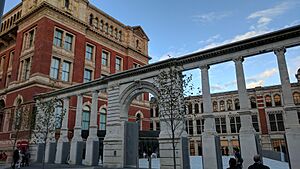
In 2011, AL A won a competition to design a new gallery. It is located beneath a new entrance courtyard on Exhibition Road. This new area opened in 2017. It provides access from Exhibition Road. The Sackler Courtyard is the world's first all-porcelain courtyard. It has 11,000 handmade porcelain tiles. A modern pavilion with glass walls houses a café. Skylights in the courtyard bring natural light to the underground gallery. The Sainsbury Gallery is a huge, column-free space. It is 1,100 square meters. This gallery hosts temporary exhibitions.
Museum Collections
The V&A's collections are vast and varied. They avoid too much overlap with other London museums. For example, the British Museum covers the classical world. The National Gallery focuses on Western paintings. However, the V&A has the main national collection of painted portrait miniatures.
The museum has four main departments: Decorative Art and Sculpture; Performance, Furniture, Textiles and Fashion; Art, Architecture, Photography and Design; and Asia. Curators look after the objects. They also make sure scholars can access items not on display.
The collection has over 6.5 million objects. Not all are displayed at the V&A. Some are stored at Blythe House. Others are lent to other institutions. The museum has 145 galleries. Only a small part of the collections can be shown at any time. Many new items are bought with help from the National Art Collections Fund.
Architecture Collection
In 2004, the V&A and the Royal Institute of British Architects (RIBA) opened a gallery. It was the first permanent gallery in the UK about architecture history. It shows models, photos, building parts, and original drawings. The RIBA Drawings and Archives Collection moved to the museum. Together, they form the world's largest architectural resource. It has over 600,000 drawings and 700,000 photographs.
The collection includes works by major British architects. It also has drawings from European and American architects. For example, the RIBA has the largest collection of drawings by Andrea Palladio.
The collection also features parts of buildings. For example, two stories of Sir Paul Pindar's house from 1600 are here. There is also a brick portal from a London house. European examples include a dormer window from a French chateau. The main architecture gallery has pillars from various buildings.
In 2022, RIBA announced it would end its partnership with the V&A in 2027. The architecture gallery at the museum will close. The items will return to RIBA's headquarters.
Asian Art
The V&A has over 160,000 objects from Asia. This is one of the largest collections of its kind. It has important collections of Chinese and South Asian art. The museum covers pieces from South and South East Asia, the Himalayas, China, Japan, Korea, and the Islamic world.
Islamic Art
The V&A has over 19,000 objects from the Islamic world. They range from the 7th to the early 20th century. The Jameel Gallery of Islamic Art opened in 2006. It displays 400 objects. The Ardabil Carpet is a highlight. The gallery shows items from Spain, North Africa, the Middle East, and Central Asia. A 10th-century rock crystal ewer is a masterpiece. Many beautiful Qur'āns are on display. A 15th-century minbar from a Cairo mosque is also featured. The collection includes ceramics, glasswork, and metalwork. The museum's collection of Middle Eastern carpets is among the best globally.
South Asian Art
The museum's South and South-East Asian art collections are very important. They have nearly 60,000 objects. This includes about 10,000 textiles and 6,000 paintings. The Jawaharlal Nehru gallery of Indian art opened in 1991. It shows art from 500 BC to the 19th century. There are many religious sculptures. The gallery also has art from the Mughal Empire. This includes portraits, jade wine cups, and gold spoons. Textiles like dyed cotton chintz and embroidery are also displayed. In 1879–80, the East India Company's India Museum collections moved to the V&A. Items include Tipu's Tiger, an 18th-century automaton. The personal wine cup of Mughal Emperor Shah Jahan is also on display.
East Asian Art
The Far Eastern collections have over 70,000 artworks. They are from China, Japan, and Korea. The T. T. Tsui Gallery of Chinese art opened in 1991. It displays about 16,000 objects from China. These date from 4000 BC to today. Many artworks are from the Ming and Qing dynasties. Older objects include a bronze head of the Buddha from 750 AD. A 2000-year-old jade horse head is also featured. The collection includes Chinese lacquer, silk, Chinese porcelain, and jade. A unique Chinese lacquerware table from the Ming dynasty is on display.
The Toshiba gallery of Japanese art opened in 1986. Most exhibits are from 1550 to 1900. An old piece is a 13th-century sculpture of Amida Nyorai. Classic Japanese armour, steel sword blades (Katana), and lacquerware are shown. The Mazarin Chest from 1640 is a fine example. Porcelain, Netsuke, and woodblock prints are also here. Suzuki Chokichi's bronze incense burner from 1875 is a huge highlight.
Smaller galleries cover Korea, the Himalayan kingdoms, and South East Asia. Korean displays include green-glazed ceramics. Himalayan works include Nepalese bronze sculptures. Tibetan art from the 14th to 19th century is also shown. Art from Thailand, Burma, Cambodia, Indonesia, and Sri Lanka is in gold, silver, and bronze.
-
Image depicting Lord Parshvanatha, India, 7th Century.
-
Image depicting Lord Rishabhanatha, 9th century, India.
Books and Manuscripts
The museum has the National Art Library. It is a public library with over 750,000 books, photos, and drawings. It is one of the world's largest libraries for fine and decorative arts. It covers all areas of the museum's collections. Special collections include illuminated manuscripts and rare books.
One of the library's treasures is the Codex Forster. This is one of Leonardo da Vinci's notebooks. It has sketches and notes from 1490 to 1505. The library also has papers from writers like Charles Dickens and Beatrix Potter. Illuminated manuscripts from the 12th to 16th centuries are also here.
The National Art Library also has a collection of comics and comic art. This includes the Krazy Kat Arkive with 4,200 comics.
British Galleries
These fifteen galleries opened in 2001. They hold about 4,000 objects. The displays focus on "Style," "Who Led Taste," and "What Was New." They cover the period from 1500 to 1900.
- Tudor and Stuart Britain (1500–1714): This includes Renaissance, Elizabethan, and Baroque styles.
- Georgian Britain (1714–1837): This covers Palladianism, Rococo, and Neoclassicism. It also shows influences from China, India, and Egypt.
- Victorian Britain (1837–1901): This includes the Gothic Revival and French influences. It also features Aestheticism, Japanese style, and the Arts and Crafts movement.
The galleries show works by British and European artists. They also display imports from Asia. Famous designers like Thomas Chippendale and William Morris are featured.
The galleries include reconstructed rooms from old buildings. For example, the parlour from 2 Henrietta Street, London, from 1727–1728. Also, the Norfolk House Music Room from 1756.
Some notable works include:
- Pietro Torrigiani's bust of Henry VII (1509–1511).
- Henry VIII's writing desk (1525).
- A spinet made for Elizabeth I (1570–1580).
- The Great Bed of Ware (1590–1600), a huge four-poster bed.
- Gianlorenzo Bernini's bust of Thomas Baker (1630s).
- The Macclesfield Wine Set (1719–1720), a rare complete silver set.
- The life-size sculpture of George Frederick Handel by Louis-François Roubiliac (1738).
- Furniture by Thomas Chippendale and Robert Adam.
The galleries also show how design linked to British culture. For example, trade with Asia brought new luxuries. The Industrial Revolution led to mass production. This created entrepreneurs like Josiah Wedgwood.
-
Great Bed of Ware, one of the world's largest beds.
Cast Courts
The Cast Courts are a dramatic part of the museum. They are two large, skylighted rooms. They hold hundreds of plaster casts of sculptures and tombs. One room has a full-size replica of Trajan's Column. It is cut in half to fit. The other room has copies of Italian Renaissance sculptures. This includes a full-size replica of Michelangelo's David.
-
Room 46b; Cast Court—Plaster Cast of "Porta Magna" of San Petronio Basilica, Bologna.
-
Room 46a; Cast Court—Plaster Cast of the 'Pórtico da Gloria' in the Cathedral of Santiago de Compostela.
-
Cast Court—Plaster copy of Trajan's Column.
Ceramics and Glass
This is the world's largest collection of ceramics and glass. It has over 80,000 objects from all over the world. Much of the top floor shows ceramics from different periods. It includes both displayed items and "visible storage" of the reserve collection.
The collection has many pieces of Meissen porcelain. This was the first factory in Europe to make porcelain like the Chinese. The Möllendorff Dinner Service from 1762 is a fine example. Ceramics from Manufacture nationale de Sèvres are also extensive. The collection of 18th-century British porcelain is the largest in the world. It includes pieces from every factory. The Salting Bequest of 1909 added many Chinese and Japanese ceramics. This includes Kakiemon ware.
Famous potters like Josiah Wedgwood and Bernard Leach are in the collection. There is a large collection of Delftware. This includes a tall flower pyramid from 1695. The largest objects are ceramic stoves from the 16th and 17th centuries. There is also a great collection of Italian maiolica. The Iznik pottery from Turkey is the largest in the world.
The glass collection covers 4,000 years of glassmaking. It has over 6,000 pieces from many continents. The earliest glassware is from Ancient Egypt. It continues through Roman, Medieval, and Renaissance periods. This includes Venetian glass and Bohemian glass. Modern styles like Art Nouveau glass by Louis Comfort Tiffany are also here. The stained glass collection is possibly the finest in the world. It covers medieval to modern periods. The Luck of Edenhall, a 13th-century glass beaker, is displayed. The huge V&A Rotunda Chandelier by Dale Chihuly is a spectacular work.
-
Maiolica dish with a childbirth scene, Urbino, c. 1546.
-
Flower pyramid, Delft, c. 1695.
-
The Luck of Edenhall, glass beaker, Syria, 13th century.
Prints and Drawings
The collection has over 750,000 works. You can see prints and drawings by appointment in the "Prints and Drawings Study Room." The drawing collection has over 10,000 British and 2,000 old master works. This includes works by Dürer, Rembrandt, and David Hockney.
The print collection has more than 500,000 objects. It covers posters, greetings cards, and old master prints. It includes works by Rembrandt, William Hogarth, and Henri Matisse.
Fashion Collection
The costume collection is the most complete in Britain. It has over 14,000 outfits and accessories. Most date from 1600 to today. The collection mainly features fashionable clothes for special events. This is because everyday clothing from the past rarely survived.
Some of the oldest items are medieval vestments. The wedding suit of James II of England is an important piece. It is displayed in the British Galleries.
In 1971, Cecil Beaton organized an exhibition of high-fashion garments. He later donated most of these items to the museum.
Since 1999, the V&A has held "Fashion in Motion" events. These are live catwalk shows featuring historical fashion. Designers like Alexander McQueen and Jean Paul Gaultier have been featured.
In 2002, the museum bought 178 Vivienne Westwood costumes. Other famous designers in the collection include Coco Chanel, Christian Dior, and Mary Quant. The museum continues to collect modern fashion.
-
1912 Lucile evening dress.
The museum has a large shoe collection. It has about 2,000 pairs from different cultures. It shows how shoe styles have changed over centuries.
Furniture Collection
In 2012, the museum opened its first gallery just for furniture. Before this, furniture was shown as part of period rooms. The new gallery highlights design and construction. Designers like Ron Arad and Frank Lloyd Wright are featured.
The furniture collection covers Europe and America. It ranges from the Middle Ages to today. It is mostly British furniture from 1700 to 1900. Pieces by Chippendale, Adam, and Morris are in the British Galleries. One of the oldest objects is a chair leg from Egypt (200-395 AD).
The collection also includes complete rooms. For example, the Boudoir of Madame de Sévilly from Paris (1781–82). Frank Lloyd Wright's Kaufmann Office (1934–1937) is also here. The museum also has the national collection of wallpaper.
Jewellery Collection
The museum's jewellery collection has over 6,000 pieces. It is one of the finest in the world. It includes works from Ancient Egypt to today. It also has jewellery designs on paper. The museum owns pieces by famous jewellers like Cartier and Peter Carl Fabergé. Other items include diamond ornaments for Catherine the Great. Bracelet clasps from Marie Antoinette are also here. The Beauharnais emerald necklace was given by Napoleon to his daughter. A new jewellery gallery opened in 2008.
Metalwork Collection
This collection has over 45,000 objects. It includes ironwork, bronze, silverware, and arms. It also has armour, pewter, and enamels. The main ironwork gallery was redesigned in 1995.
There are over 10,000 silver or gold objects. The display shows both everyday and religious items. The collection includes the oldest known English silver with a dated hallmark (1496–1497).
The main ironwork gallery covers European ironwork. It ranges from medieval times to the early 20th century. The Hereford Screen is one of the largest objects. It weighs almost 8 tonnes and is 10.5 meters high. It was designed by Sir George Gilbert Scott in 1862.
One of the rarest works is the Gloucester Candlestick (c1110). It is made from gilt bronze. The Becket Casket (c1180) holds relics of St Thomas Becket. The Burghley Nef, a salt-cellar from 1527–1528, is also unique. These items are in the new Medieval & Renaissance galleries.
-
The Burghley Nef—Silver-gilt salt cellar, France, 1527–28.
-
Tabernacle, Cologne, Germany, c. 1180.
Musical Instruments
Musical instruments are part of the furniture collection. Asian instruments are in their own departments.
Important instruments include a violin by Antonio Stradivari (1699). An oboe that belonged to Gioachino Rossini is also here. A jewelled spinet from 1571 is another highlight. The collection also has a virginal said to belong to Elizabeth I.
The Musical Instruments gallery closed in 2010. This was a controversial decision. The museum plans to keep the collection available to the public. Some instruments are now in other galleries. Others are on loan to places like the Horniman Museum.
Paintings and Miniatures
The collection has about 1,130 British and 650 European oil paintings. It also has 6,800 British watercolours and 2,000 miniatures. The museum holds the national collection of miniatures. The Raphael Cartoons are on loan from Queen Elizabeth II. These are seven large designs for tapestries in the Sistine Chapel.
19th-century British artists are well represented. John Constable and J. M. W. Turner have many works here. One unusual item is Thomas Gainsborough's showbox. He painted landscapes on glass for it.
In 1857, John Sheepshanks donated 233 paintings. These were mainly by British artists. This helped form a 'National Gallery of British Art'. Artists like William Blake and Millais are included. Constable's daughter Isabel donated many of his works in 1888. This included the large oil sketch for The Hay Wain.
-
Botticelli—Portrait of a Lady known as Smeralda Brandini, 1470-1475.
-
Rembrandt—The Departure of the Shunammite Woman, c. 1640.
-
Tintoretto—Self-Portrait as a Young Man, c. 1548.
-
Raphael—The Miraculous Draught of Fishes, 1515.
-
Raphael—St Paul Preaching in Athens, 1515.
Photography Collection
The collection has over 500,000 images. They date from the start of photography in 1839. The gallery shows changing exhibits. In 1858, the museum held the world's first international photography exhibition.
The collection includes work by Fox Talbot, Julia Margaret Cameron, and Man Ray. It also has photos by Henri Cartier-Bresson and David Bailey. One unique collection is Eadweard Muybridge's "Animal Locomotion" photos from 1887. These show animals and humans in motion.
Sculpture Collection
The V&A has the most complete collection of post-classical European sculpture in the world. It has about 22,000 objects. These cover from 400 AD to 1914. This includes Byzantine and Anglo Saxon ivory sculptures. It also has medieval, Renaissance, and Baroque pieces. The sculptures are for tombs, portraits, and gardens. Materials include marble, wood, ivory, and bronze.
The collection of Italian sculpture is unmatched outside Italy. It includes Canova's The Three Graces. Italian sculptors like Donatello and Michelangelo are represented. Michelangelo is shown by a wax model and casts. Bernini's Neptune and Triton is also here.
Rodin is represented by over 20 works. This is one of the largest collections of his work outside France. He gave these to the museum in 1914.
The Dorothy and Michael Hintze sculpture galleries opened in 2006. They now show works up to 1950. This includes pieces by Henry Moore and Jacob Epstein. The galleries are arranged by themes like tomb sculpture and mythology.
-
Donatello—One of the finest examples of Donatello's work.
-
Andrea della Robbia—Adoration of the Magi.
-
Canova—Theseus.
Textiles Collection
The textile collection has over 53,000 examples. Most are Western European. They date from the 1st century AD to today. This is the largest such collection in the world. It includes weaving, printing, quilting, and lace. Early silks from the Near East are well represented. European tapestries and English medieval church embroidery are also highlights.
The tapestry collection includes a piece of the Cloth of St Gereon. This is the oldest known European tapestry. The four Devonshire Hunting Tapestries are very rare. They are 15th-century tapestries from the Netherlands.
The Tristan Quilt is one of the earliest European quilts. It is from Sicily and dates to the late 14th century. The collection has many textiles designed by William Morris. This includes embroidery, woven fabrics, and tapestries.
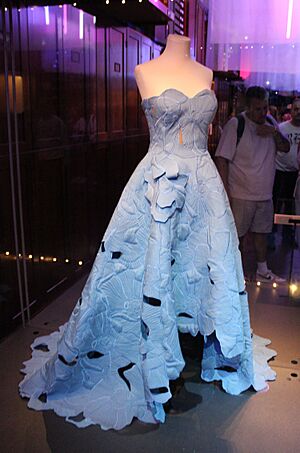
Theatre and Performance
The V&A holds the UK's national collection of performing arts. This includes drama, dance, opera, and music. The collections started in the 1920s. Gabrielle Enthoven donated her theatrical items.
The collections were displayed at the Theatre Museum until 2007. Theatre & Performance galleries opened at South Kensington in 2009. They show costumes, set models, and posters.
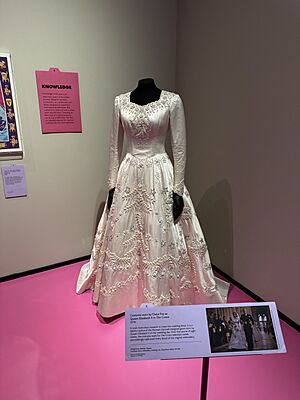
The department has important archives. These include the Glastonbury Festival archive. Costumes worn by John Lennon, Mick Jagger, and Taylor Swift are also here.
In 2024, the museum displayed costumes worn by Taylor Swift. The exhibition was called Taylor Swift Songbook Trail. It had 13 stops throughout the museum.
Museum Activities
Learning and Education
The education department helps all visitors. It provides information for school groups. It links museum learning with the National Curriculum. It also offers research facilities for students. The department oversees the museum's website. It also publishes books about the collections.
Some collections have special study rooms. These allow access to objects not on display. The new Sackler education suite opened in 2008. It has lecture rooms and areas for schools. These are also open to families during holidays.
Books and Digital Content
V&A Publishing creates books and digital items. This helps raise money for the museum. They publish about 30 new items each year. They have about 180 books in print.
Fun for Kids
Activity backpacks are available for children. They are free to borrow. They include puzzles, games, and stories. These activities are related to the museum's themes.
Adult Learning
The Learning Academy offers courses for adults. It also trains professionals in culture and heritage. The museum has great facilities for studying its collections.
Research and Conservation
Research is a key part of the museum's work. It helps identify and understand objects. It also helps people learn about world cultures. Visitor research helps the museum meet visitors' needs. The museum has published research reports since 1990.
Conservation protects the collections for the long term. This includes all items at the V&A and the Young V&A. Conservators specialize in different areas. "Preventive" conservation involves surveys and advice. It helps prevent damage to objects. This includes controlling temperature and light. It also stops pests from harming artifacts. "Interventive" conservation involves cleaning and repairing fragile objects. This makes them more stable and attractive for display.
National Art Library
The National Art Library merged with the Prints, Paintings and Drawings department. It is now part of the Word and Image Department. The library and its reading rooms are on the second floor. Some collections are stored off-site.
Museum Partnerships

The V&A works with partners in places like Sheffield, Dundee, and Blackpool. This helps the museum have a presence outside London.
The V&A worked with the University of Dundee and the Scottish Government. This led to the opening of V&A Dundee in 2018. It cost £80.11 million. It focuses on Scottish design. The V&A provides expertise and loans.
Plans for a new gallery in Blackpool are also being considered. The V&A also exhibits twice a year at the Millennium Galleries in Sheffield.
The V&A is part of "Discover Islamic Art." This online project brings together Islamic art and architecture. In 2009, the V&A started the Jameel Prize. This award is for "contemporary art and design inspired by Islamic tradition."
The V&A is a major hub for the London Design Festival (LDF). It hosts many exhibitions and events. It is seen as the "true epicentre" of the festival.
The museum is a public body. It is sponsored by the Department for Culture, Media and Sport. Entrance to the museum is free.
Special Exhibitions
The V&A has large galleries for temporary exhibitions. Each year, more than a dozen different shows are staged. They cover all areas of the collections. Some notable past exhibitions include:
- Britain Can Make It, 1946
- David Bowie Is, 2013
- Taylor Swift Songbook Trail, 2024
The Alexander McQueen show in 2015 was very popular. It was London's second most visited paid exhibition that year.
Media Features
In March 2020, BBC Two aired a series called Secrets of the Museum. It showed the work of the museum's curators and restorers.
The Sculpture Gallery was featured in the 2023 romantic comedy Red, White & Royal Blue.
Images for kids
-
Louis-François Roubiliac's George Frederick Handel.
-
William Burges decanter.
-
Sideboard by Edward William Godwin, 1867–1870 V&A Museum no. CIRC.38:1 to 5–1953 (Room 125).
-
George Gilbert Scott—Screen from Hereford Cathedral, 1862.
-
John Constable—View of Salisbury Cathedral, 1823.
-
J. M. W. Turner—Venice from the Giudecca, 1840.
-
John Everett Millais—Pizarro Seizing the Inca of Peru, 1846.
-
François Boucher—Madame de Pompadour, Mistress of Louis XV, 1758.
-
Nicolas Lancret—The Swing, 1735.
-
Sandro Botticelli – Portrait of a Lady Known as Smeralda Brandini, c. 1475.
-
Luca Carlevarijs— Two Studies of Men, c. 1700–1710.
-
Pietro Perugino— The Nativity; the Virgin, Saint Joseph and the Shepherds adoring the Infant Christ.
-
Giovanni Battista Tiepolo— St Leo in Glory.
-
Room 22—Sculpture 1600–1870, Canova—Theseus and the Minotaur.
See also
 In Spanish: Museo de Victoria y Alberto para niños
In Spanish: Museo de Victoria y Alberto para niños


